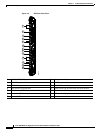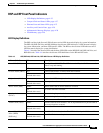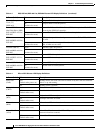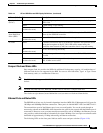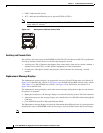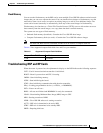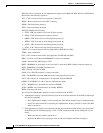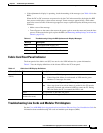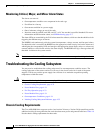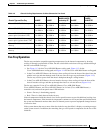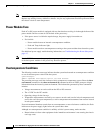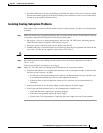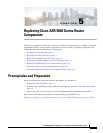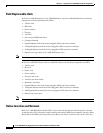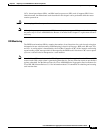
4-32
Cisco ASR 9000 Series Aggregation Services Router Hardware Installation Guide
Chapter 4 Troubleshooting the Installation
Troubleshooting the Cooling Subsystem
Monitoring Critical, Major, and Minor Alarm Status
The alarms can warn of:
• Overtemperature condition on a component in the card cage
• Fan failure in a fan tray
• Overcurrent condition in a power supply
• Out-of-tolerance voltage on one of the cards
• Insertion count for an RSP card, RP, card, FC, or LC has reached a specified threshold. For more
information on OIR insertion counts, see OIR Monitoring, page 5-3.
The alarm LEDs are controlled by the CAN microcontroller software, which sets the threshold levels for
triggering the different stages of alarms.
The RSP/RP card continuously polls the system for temperature, voltage, current, and fan speed values.
If a threshold value is exceeded, the RSP/RP sets the appropriate alarm severity level on the alarm card,
which lights the corresponding LED, and energizes the appropriate alarm display relays to activate any
external audible or visual alarms wired to the alarm display. The RSP/RP also logs a message about the
threshold violation on the system console.
Note If one or more of the alarm LEDs is on, check the system console for messages describing the alarm.
Troubleshooting the Cooling Subsystem
You may need to troubleshoot the cooling subsystem if an overtemperature condition occurs. The
cooling subsystem of the router consists of a fan tray in the chassis and a fan in each of the power
supplies. The fan tray and the power supply fans circulate air to maintain acceptable operating
temperatures within the router.
Caution When troubleshooting the fan trays, never unplug all the fan trays at the same time.
• Chassis Cooling Requirements, page 4-32
• Power Module Fans, page 4-34
• Fan Tray Operation, page 4-33
• Power Module Fans, page 4-34
• Overtemperature Conditions, page 4-34
• Isolating Cooling Subsystem Problems, page 4-35
Chassis Cooling Requirements
The Cisco ASR 9000 Series supports version 1 and version 2 fan trays. Version 2 high-speed fans provide
additional cooling for new generation line cards that draw more power and generate more heat. Table 4-8
lists the chassis cooling requirements for these cards.



